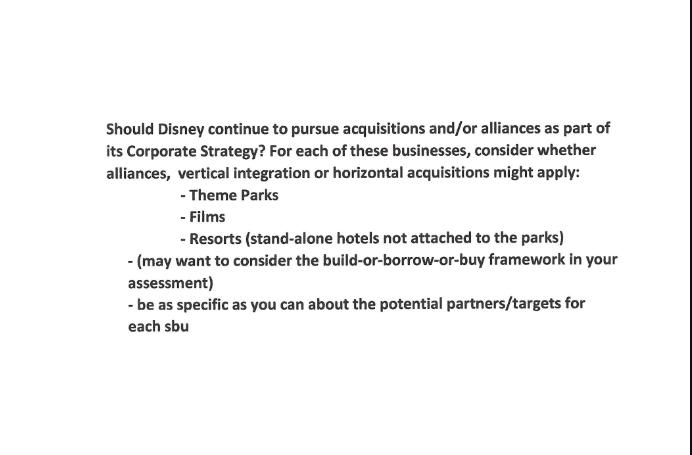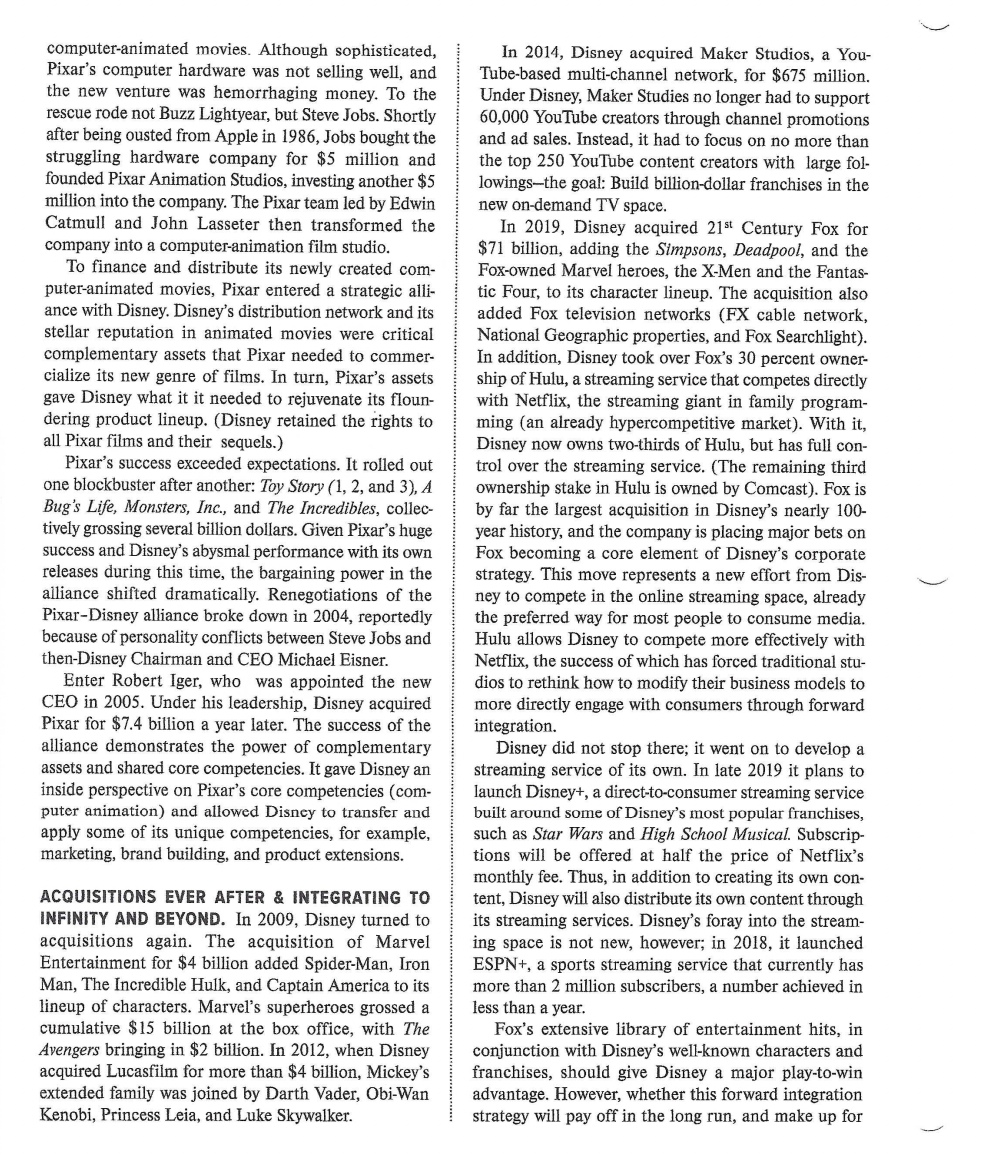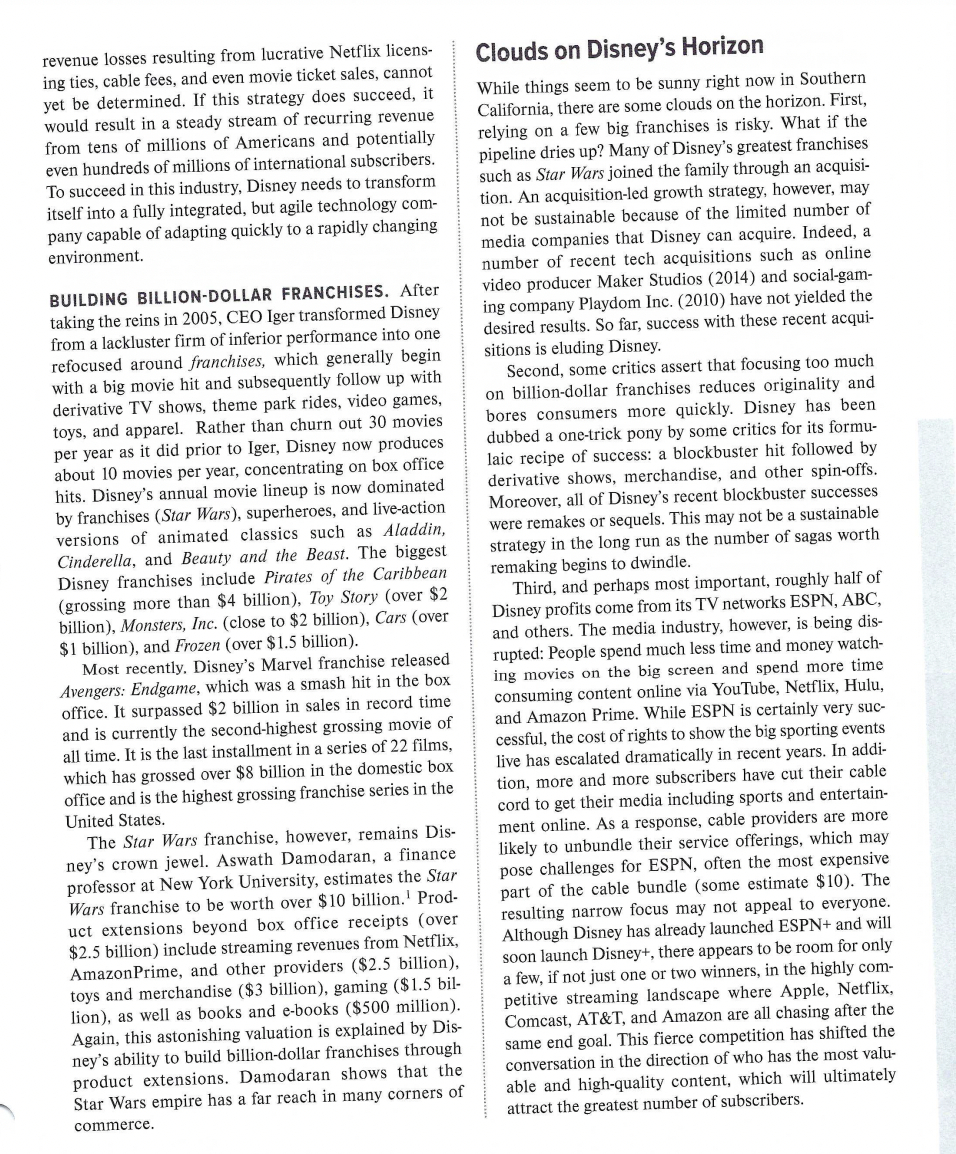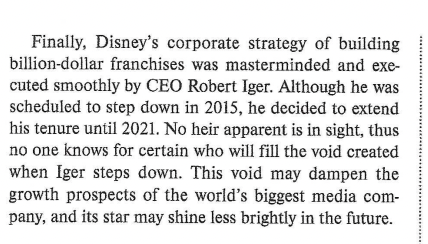Answered step by step
Verified Expert Solution
Question
1 Approved Answer
Should Disney continue to pursue acquisitions and/or alliances as part of its Corporate Strategy? For each of these businesses, consider whether alliances, vertical integration





Should Disney continue to pursue acquisitions and/or alliances as part of its Corporate Strategy? For each of these businesses, consider whether alliances, vertical integration or horizontal acquisitions might apply: -Theme Parks - Films - Resorts (stand-alone hotels not attached to the parks) - (may want to consider the build-or-borrow-or-buy framework in your assessment) - be as specific as you can about the potential partners/targets for each sbu MiniCase 9 Disney: Building Billion-Dollar Franchises DISNEY IS the world's largest media company and is world-renowned for its Walt Disney Studios and the popular Walt Disney Parks and Resorts. In 2019 it achieved $60 billion in annual revenues. As a diversi- fied media company, Disney is active in a wide array of business activities-movies, amusement parks, cable and broadcast television networks (ABC, ESPN, and others), as well as cruises, retailing, and streaming. It became the world's leading media company by pursuing a corporate strategy of diversification and ver- tical integration, executed through a series of high-pro- file acquisitions, which included Pixar (2006), Marvel (2009), Lucasfilm (2012) (the creator of Star Wars), and 21st Century Fox (2019). Disney's Corporate Strategy Disney's main goal in pursuing its corporate strategy is to build billion-dollar franchises based on movie se- quels, park rides, and merchandise. CEO Robert Iger leads a group of about 20 executives whose sole re- sponsibility is to hunt for new billion-dollar franchises. This group of senior leaders decides top-down which projects are a go and which are not. They also allocate resources to particular projects. Disney even organizes its employees into consumer product groups built around franchises such as Frozen, Toy Story, Star Wars, and other cash cows. Disney's corporate strategy around building billion-dollar franchises is certainly paying off: It has seen steady growth, earning $14 bil- lion in profits in 2019-up from a mere $3 billion a de- cade earlier. Disney has been the most profitable movie studio for years and thus has enjoyed a sustained com- petitive advantage. This MiniCase was prepared by Frank T. Rothaermel with Laura Zhang, who provided superb research assistance. This MiniCase is developed for the pur- pose of class discussion. It is not intended to be used for any kind of endorse- ment, source of data, or depiction of efficient or inefficient management. All opinions expressed, all errors and omissions are entirely the author's. Revised and undated: June 7, 2019, Frank T. Rothaermel. STAR HE LAST JED WARS Star Wars: The Last Jedi is part of the global Star Wars franchise. This sequel alone grossed over $1.3 billion in the box office. Matthew Leane/Alamy Stock Photo DISNEY AND PIXAR: "TRY BEFORE YOU BUY." To understand how Disney's corporate strategy of growth through acquisition came about, let's look at one of its most successful deals: Disney's acquisition of Pixar, around which it then built a number of billion-dollar franchises. It all began with a strategic alliance. Pixar started as a computer hardware company that produced high-end graphic display systems. One of its customers was Disney. To demonstrate the capabilities of the graphic display systems, Pixar produced short, computer-animated movies. Although sophisticated, Pixar's computer hardware was not selling well, and the new venture was hemorrhaging money. To the rescue rode not Buzz Lightyear, but Steve Jobs. Shortly after being ousted from Apple in 1986, Jobs bought the struggling hardware company for $5 million and founded Pixar Animation Studios, investing another $5 million into the company. The Pixar team led by Edwin Catmull and John Lasseter then transformed the company into a computer-animation film studio. To finance and distribute its newly created com- puter-animated movies, Pixar entered a strategic alli- ance with Disney. Disney's distribution network and its stellar reputation in animated movies were critical complementary assets that Pixar needed to commer- cialize its new genre of films. In turn, Pixar's assets gave Disney what it it needed to rejuvenate its floun- dering product lineup. (Disney retained the rights to all Pixar films and their sequels.) Pixar's success exceeded expectations. It rolled out one blockbuster after another: Toy Story (1, 2, and 3), A Bug's Life, Monsters, Inc., and The Incredibles, collec- tively grossing several billion dollars. Given Pixar's huge success and Disney's abysmal performance with its own releases during this time, the bargaining power in the alliance shifted dramatically. Renegotiations of the Pixar-Disney alliance broke down in 2004, reportedly because of personality conflicts between Steve Jobs and then-Disney Chairman and CEO Michael Eisner. Enter Robert Iger, who was appointed the new CEO in 2005. Under his leadership, Disney acquired Pixar for $7.4 billion a year later. The success of the alliance demonstrates the power of complementary assets and shared core competencies. It gave Disney an inside perspective on Pixar's core competencies (com- puter animation) and allowed Disney to transfer and apply some of its unique competencies, for example, marketing, brand building, and product extensions. ACQUISITIONS EVER AFTER & INTEGRATING TO INFINITY AND BEYOND. In 2009, Disney turned to acquisitions again. The acquisition of Marvel Entertainment for $4 billion added Spider-Man, Iron Man, The Incredible Hulk, and Captain America to its lineup of characters. Marvel's superheroes grossed a cumulative $15 billion at the box office, with The Avengers bringing in $2 billion. In 2012, when Disney acquired Lucasfilm for more than $4 billion, Mickey's extended family was joined by Darth Vader, Obi-Wan Kenobi, Princess Leia, and Luke Skywalker. In 2014, Disney acquired Maker Studios, a You- Tube-based multi-channel network, for $675 million. Under Disney, Maker Studies no longer had to support 60,000 YouTube creators through channel promotions and ad sales. Instead, it had to focus on no more than the top 250 YouTube content creators with large fol- lowings-the goal: Build billion-dollar franchises in the new on-demand TV space. In 2019, Disney acquired 21st Century Fox for $71 billion, adding the Simpsons, Deadpool, and the Fox-owned Marvel heroes, the X-Men and the Fantas- tic Four, to its character lineup. The acquisition also added Fox television networks (FX cable network, National Geographic properties, and Fox Searchlight). In addition, Disney took over Fox's 30 percent owner- ship of Hulu, a streaming service that competes directly with Netflix, the streaming giant in family program- ming (an already hypercompetitive market). With it, Disney now owns two-thirds of Hulu, but has full con- trol over the streaming service. (The remaining third ownership stake in Hulu is owned by Comcast). Fox is by far the largest acquisition in Disney's nearly 100- year history, and the company is placing major bets on Fox becoming a core element of Disney's corporate strategy. This move represents a new effort from Dis- ney to compete in the online streaming space, already the preferred way for most people to consume media. Hulu allows Disney to compete more effectively with Netflix, the success of which has forced traditional stu- dios to rethink how to modify their business models to more directly engage with consumers through forward integration. Disney did not stop there; it went on to develop a streaming service of its own. In late 2019 it plans to launch Disney+, a direct-to-consumer streaming service built around some of Disney's most popular franchises, such as Star Wars and High School Musical. Subscrip- tions will be offered at half the price of Netflix's monthly fee. Thus, in addition to creating its own con- tent, Disney will also distribute its own content through its streaming services. Disney's foray into the stream- ing space is not new, however; in 2018, it launched ESPN+, a sports streaming service that currently has more than 2 million subscribers, a number achieved in less than a year. Fox's extensive library of entertainment hits, in conjunction with Disney's well-known characters and franchises, should give Disney a major play-to-win advantage. However, whether this forward integration strategy will pay off in the long run, and make up for revenue losses resulting from lucrative Netflix licens- ing ties, cable fees, and even movie ticket sales, cannot yet be determined. If this strategy does succeed, it would result in a steady stream of recurring revenue from tens of millions of Americans and potentially even hundreds of millions of international subscribers. To succeed in this industry, Disney needs to transform itself into a fully integrated, but agile technology com- pany capable of adapting quickly to a rapidly changing environment. BUILDING BILLION-DOLLAR FRANCHISES. After taking the reins in 2005, CEO Iger transformed Disney from a lackluster firm of inferior performance into one refocused around franchises, which generally begin with a big movie hit and subsequently follow up with derivative TV shows, theme park rides, video games, toys, and apparel. Rather than churn out 30 movies per year as it did prior to Iger, Disney now produces about 10 movies per year, concentrating on box office hits. Disney's annual movie lineup is now dominated by franchises (Star Wars), superheroes, and live-action versions of animated classics such as Aladdin, Cinderella, and Beauty and the Beast. The biggest Disney franchises include Pirates of the Caribbean (grossing more than $4 billion), Toy Story (over $2 billion), Monsters, Inc. (close to $2 billion), Cars (over $1 billion), and Frozen (over $1.5 billion). Most recently. Disney's Marvel franchise released Avengers: Endgame, which was a smash hit in the box office. It surpassed $2 billion in sales in record time and is currently the second-highest grossing movie of all time. It is the last installment in a series of 22 films, which has grossed over $8 billion in the domestic box office and is the highest grossing franchise series in the United States. The Star Wars franchise, however, remains Dis- ney's crown jewel. Aswath Damodaran, a finance professor at New York University, estimates the Star Wars franchise to be worth over $10 billion.' Prod- uct extensions beyond box office receipts (over $2.5 billion) include streaming revenues from Netflix, Amazon Prime, and other providers ($2.5 billion), toys and merchandise ($3 billion), gaming ($1.5 bil- lion), as well as books and e-books ($500 million). Again, this astonishing valuation is explained by Dis- ney's ability to build billion-dollar franchises through product extensions. Damodaran shows that the Star Wars empire has a far reach in many corners of commerce. Clouds on Disney's Horizon While things seem to be sunny right now in Southern California, there are some clouds on the horizon. First, relying on a few big franchises is risky. What if the pipeline dries up? Many of Disney's greatest franchises such as Star Wars joined the family through an acquisi- tion. An acquisition-led growth strategy, however, may not be sustainable because of the limited number of media companies that Disney can acquire. Indeed, a number of recent tech acquisitions such as online video producer Maker Studios (2014) and social-gam- ing company Playdom Inc. (2010) have not yielded the desired results. So far, success with these recent acqui- sitions is eluding Disney. Second, some critics assert that focusing too much on billion-dollar franchises reduces originality and bores consumers more quickly. Disney has been dubbed a one-trick pony by some critics for its formu- laic recipe of success: a blockbuster hit followed by derivative shows, merchandise, and other spin-offs. Moreover, all of Disney's recent blockbuster successes were remakes or sequels. This may not be a sustainable strategy in the long run as the number of sagas worth remaking begins to dwindle. Third, and perhaps most important, roughly half of Disney profits come from its TV networks ESPN, ABC, and others. The media industry, however, is being dis- rupted: People spend much less time and money watch- ing movies on the big screen and spend more time consuming content online via YouTube, Netflix, Hulu, and Amazon Prime. While ESPN is certainly very suc- cessful, the cost of rights to show the big sporting events live has escalated dramatically in recent years. In addi- tion, more and more subscribers have cut their cable cord to get their media including sports and entertain- ment online. As a response, cable providers are more likely to unbundle their service offerings, which may pose challenges for ESPN, often the most expensive part of the cable bundle (some estimate $10). The resulting narrow focus may not appeal to everyone. Although Disney has already launched ESPN+ and will soon launch Disney+, there appears to be room for only a few, if not just one or two winners, in the highly com- petitive streaming landscape where Apple, Netflix, Comcast, AT&T, and Amazon are all chasing after the same end goal. This fierce competition has shifted the conversation in the direction of who has the most valu- able and high-quality content, which will ultimately attract the greatest number of subscribers. Finally, Disney's corporate strategy of building billion-dollar franchises was masterminded and exe- cuted smoothly by CEO Robert Iger. Although he was scheduled to step down in 2015, he decided to extend his tenure until 2021. No heir apparent is in sight, thus no one knows for certain who will fill the void created when Iger steps down. This void may dampen the growth prospects of the world's biggest media com- pany, and its star may shine less brightly in the future.
Step by Step Solution
There are 3 Steps involved in it
Step: 1

Get Instant Access to Expert-Tailored Solutions
See step-by-step solutions with expert insights and AI powered tools for academic success
Step: 2

Step: 3

Ace Your Homework with AI
Get the answers you need in no time with our AI-driven, step-by-step assistance
Get Started


